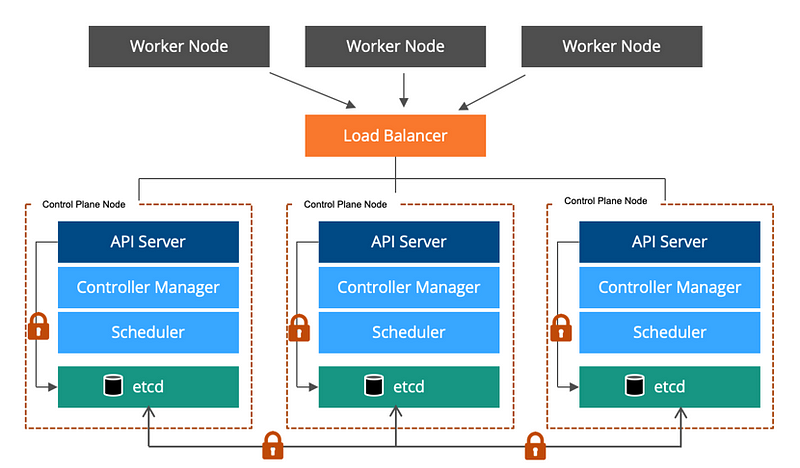Understanding etcd in Kubernetes
Introduction

Introduction
etcd is an open-source, distributed key-value store designed for shared configuration, service discovery, and coordination within distributed systems. It plays a vital role in maintaining applications’ high availability and reliability by ensuring that all the data spread across clusters is consistent and synchronised. Developed by CoreOS in 2013, etcd is written in Go language and is a core component in Kubernetes for storing and replicating data across all nodes in a cluster.
Understanding etcd: What it is, and Why it’s Critical
etcd is a consistent, highly available distributed key-value store using the Raft consensus algorithm to manage a highly-available replicated log. It provides a reliable way to store data across a cluster of machines, ensuring that data remains consistent even during network partitioning. The data stored in etcd can be accessed by all nodes in a cluster, which can use the stored information for coordination and configuration sharing.
etcd has proven crucial in building distributed systems because it provides a shared source of truth, effectively managing configuration data, naming, providing distributed locking, and managing state. With etcd, developers can ensure the correctness and reliability of their distributed systems and the smooth and efficient operation of their applications.
Key Features of etcd
- Strong consistency: etcd uses the Raft consensus algorithm to ensure every read receives the most recent write.
- Reliability: etcd maintains high availability through automatic leader election. If a leader fails, the system can quickly elect a new leader, preventing downtime.
- Security: etcd supports secure communication by providing automatic TLS with optional client cert authentication. It also provides Role-Based Access Control (RBAC), ensuring only authorised entities access data.
- Observability: etcd exposes detailed metrics in the Prometheus format, enabling robust monitoring.
- APIs: etcd provides simple APIs, including gRPC for issuing commands and watching fundamental changes, making it easy to build applications around.
How etcd Works
etcd uses the Raft consensus algorithm to manage a highly-available replicated log. It groups instances into clusters, each with a unique ID. Each cluster has a leader who handles client requests and follower instances that replicate the leader’s log entries. If a leader fails, the followers hold an election to choose a new leader.
The clients send write requests to the leader, which are then appended to its log. The leader subsequently broadcasts these entries to their followers. Once an entry has been safely replicated, the leader applies the entry to its state machine and returns the result of that execution to the client.
etcd provides a watch API for applications to monitor changes in keys and directories, providing real-time updates as data changes.
Use of etcd in Kubernetes
Kubernetes uses etcd as its primary datastore to manage the cluster state. All cluster data, including the configuration data and the state of workloads running within the cluster, is stored in etcd. It keeps track of nodes, pods, configs, secrets, accounts, roles, and bindings. etcd ensures that even if individual nodes within a Kubernetes cluster fail, the cluster’s state remains consistent and highly available.
Advanced Features of etcd
Beyond its fundamental characteristics, etcd provides additional capabilities that are valuable in distributed environments:
- Transaction Support: etcd supports multi-key transactions with conditional flow. This means several operations can be grouped and executed in a single atomic transaction. If the transaction fails at any step, all the changes are rolled back, ensuring data integrity.
- Time to Live (TTL): etcd provides TTL for keys, which can be used for automatic key expiration. This is particularly useful for use cases like service discovery and leader election, where outdated entries should be automatically removed after a certain period.
- Lease Mechanism: etcd provides a lease mechanism that can be used to associate keys with a lease. The keys are automatically deleted when the lease expires. This is particularly useful for managing short-lived keys.
- Mirror and Proxy Modes: etcd can operate in mirror mode, which mirrors a prefix in the key-value store to another etcd cluster, and in proxy mode, which forwards the etcd API requests to an active etcd cluster.
Operational Aspects of etcd
etcd is designed to be simple to operate. It can be efficiently run in containers or managed using systemd. It provides detailed log output for troubleshooting and supports seamless cluster resizing.
etcd provides a command-line client called etcdctl for administrative tasks like setting and retrieving key-value pairs, creating and managing clusters, and diagnosing cluster health. It also provides APIs, including a gRPC-based API that supports various programming languages.
etcd performance can be tuned by adjusting parameters like heartbeat interval and election timeout. It can be benchmarked using tools like etcd-bench to help understand the performance characteristics under different workloads.
Best Practices for Using etcd
When deploying etcd in a production environment, consider the following best practices:
- Securing etcd: Use TLS for client-server communications and enable RBAC to control access to etcd data.
- Data Backup: Regularly back up etcd data. Kubernetes, for example, can use the etcdctl snapshot save command to create snapshots of etcd.
- Monitoring: Continuously monitor etcd instances using the metrics it exposes.
- Proper Sizing: Maintain an odd number of members in an etcd cluster to avoid a split-brain scenario in case of network partitioning. A cluster of three or five nodes is typical in production environments.
etcd is a highly reliable, distributed key-value store that serves as the backbone of distributed systems, providing strong consistency and high availability. Understanding its workings, advanced features, and best practices can significantly contribute to building and maintaining robust distributed applications.
Stay tuned, and happy coding!
Visit my Blog for more articles, news, and software engineering stuff!
Follow me on Medium, LinkedIn, and Twitter.
All the best,
Luis Soares
Senior Java Engineer | Tech Lead | AWS Solutions Architect | Rust | Golang | Java | TypeScript | Web3 & Blockchain
#kubernetes #k8s #etcd #nodes #pods #data #observability #highavailability #architecture #softwaredevelopment #coding #software #development #building #architecture



